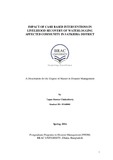Impact of cash based interventions in livelihood recovery of waterlogging affected community in Satkhira district

View/
Date
2016Publisher
BRAC UniversityAuthor
Chakraborty, Tapan KumarMetadata
Show full item recordAbstract
The coastal districts of SWB have been experiencing waterlogging problem since the early 1980s. Natural drainage systems over a large part of this area were totally disrupted, as a result, with most of the effective natural water collection and drainage system blocked by the polders. The situation has aggravated greatly since 2011 as a result of multi-dimensional causes accrued form both natural and manmade disaster.In 2013, this was about 28% of the land area in the affected Upazilas and remained waterlogged for more than 8 months. Long term inundation prevents the cultivation of most of the crops normally cultivated in this area resulting in very significant economic loss to the households. The main affected groups due to water logging in these Upazilas are landless day laborers, small and marginal farmers, who faced major losses in terms of livelihoods or source of income (from land or labor). Small and marginal farmers have lost their livelihoods and casual day labors have lost employment opportunity, consequently fall in chronic food insecurity. Affected people had to rely on negative coping strategies such as selling productive assets, spending previous savings, migration and borrowing for survival.
Humanitarian intervention has started in 2012 by International NGOs and UN agencies. As markets were functional, Cash Based Intervention (CBI) was carried out to support the affected population to meet the immediate food security need and livelihoods recovery. Different survey and project reports say that total 44,210 most vulnerable households affected by waterlogging received BDT 465, 934,000 in three districts up to December 2015. This study aims to evaluate if theseCBIs helped the beneficiary households for recovery of the livelihoods and contributed to enhance their resilience against flood and waterlogging. The study used 7 parameters to understand if the beneficiaries managed to recover the livelihoods they lost due to waterlogging. These are – 1) Changes in occupation and livelihoods strategies 2) Adoption of alternative and diversified livelihoods options 3) Recuperation of household assets 4) Increase of total asset value 5) Reduction of burden of debt 6) Increased monthly income 7) Improvement of community infrastructures. Waterlogging affected households shifted from traditional occupations like agriculture farming and casual day labors to new occupation and livelihoods strategies. Number of main occupation increased from 4 types (before waterlogging) to 8in 2016. All of the respondent households now have at least 2 livelihoods options and out of them 44% currently have 3 livelihoods options. Beneficiaries managed to regain almost all productive assets except cultivable land. Average number of cows and goats surpassed the number before waterlogging. Total value of assets stood at BDT 123, 442 and surpassed the asset value of 2010 by BDT 32,094. Burden of loan per household reduced from BDT 13,917 to BDT 7,966. Monthly income has increased in average BDT 2800 compared to the monthly income before waterlogging.
Therefore, CBIs found very much effective in recovery of livelihoods of the waterlogging affected marginalized households and built their resilience to cope with the waterlogging condition. It also contributed a lot by reducing future risk of waterlogging through rehabilitation of the community infrastructures and making them functional.
